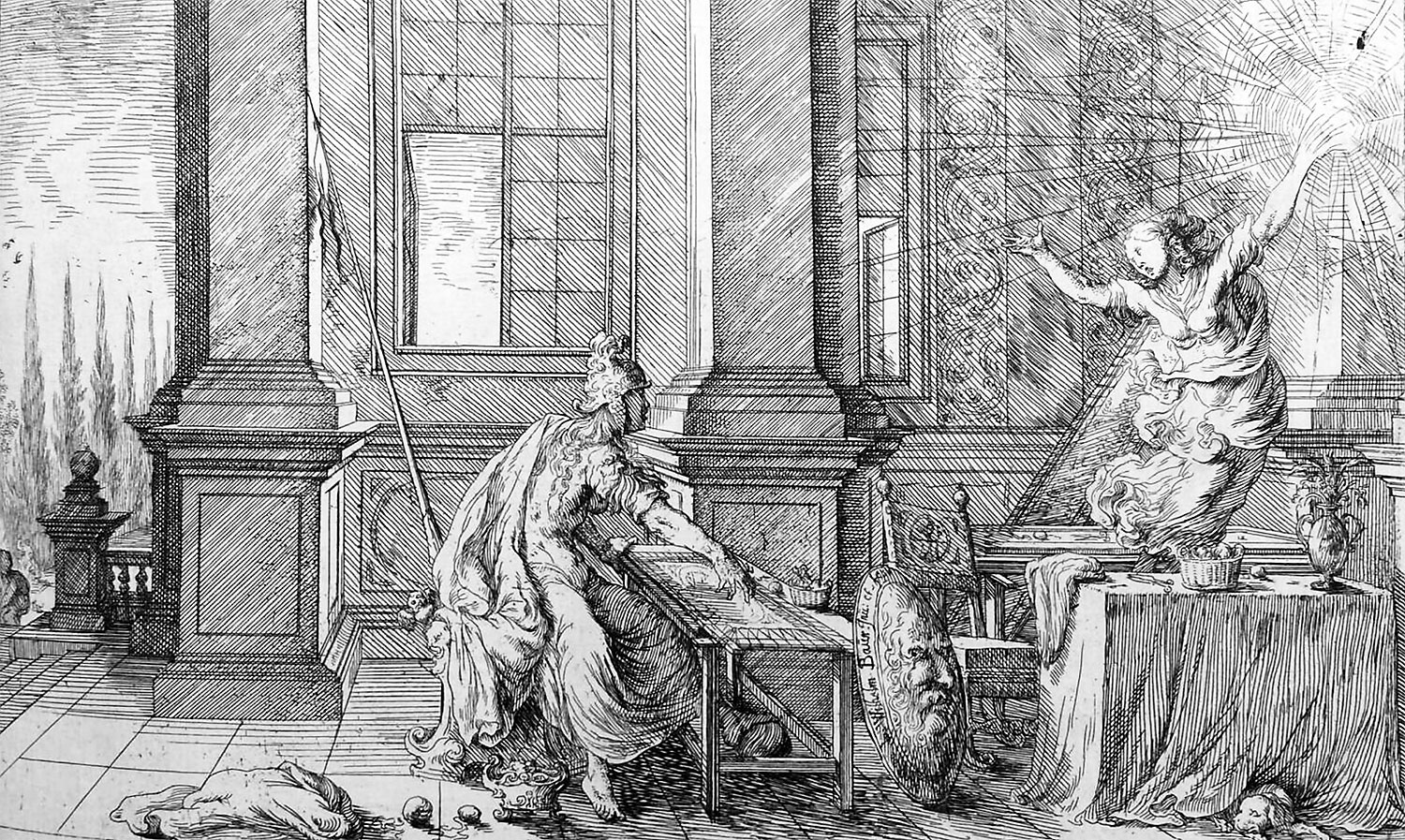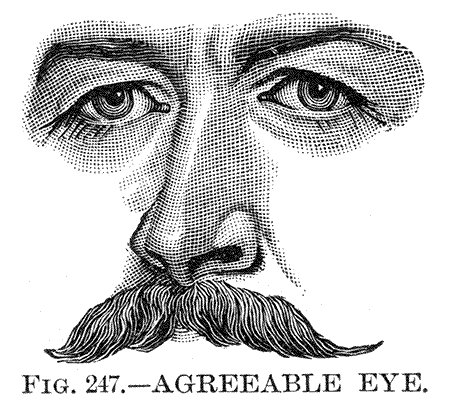moth-eaten notions

Minerva and Arachne, engraving by Johann Wilhelm Baur (1641)
…a garment becomes a real garment only in the act of being worn; a house where no one lives is in fact not a real house…
But truly, for mine own part, if I were as tedious as a king, I could find it in my heart to bestow it all of your worship.
At the guesthouse near the sea, there is a table in the library that is usually home to a jigsaw puzzle. The puzzle ends up being a communal project, with invisible hands piecing together fragments of a well-known eye, a bit of sneer, 2 or a mass of indistinguishable monsters until the puzzle’s done. It remains on the table for an hour or two, for all the puzzlers (and the puzzled) to see (curious that it matches the image on the box top), and then it is returned to the box, which is returned to the shelf, and the next puzzle is taken down, the edge pieces sorted to establish the empty space of the image and make room for a new beginning.
* * *
Wissen sie nichts; was braucht die Welt einen gelehrten Beweis davon? (p. 48)
They know nothing; why does the world need a learned demonstration of it? (p. 167)
A problem I encountered in the writings of Adam Smith is that (a) they assume a rational system and (b) they assume rational actors. It needs no economist come from the far side of the grave to sense that markets (and their actors) are not entirely rational and that these are, therefore, rather large assumptions. These assumptions are also entirely of their period, that time of enlightened, hopeful reasonableness (and the concomitant barbarities of near constant warfare and banditry): there is of course the irony that one is rarely so concerned with reason as when one is being most unreasonable. It is this irony, I think, that Hamann is keen to account for in his Socratic Memorabilia, hence his concern with historiography, critical forms (and forms of criticism), and the character of Socrates, the daimon-plagued mouche on dame philosophy’s visage. 3
The peculiarities (some would say the charms) of Hamann’s style call for, even if they do not necessarily reward, attempts at close reading. This is curious. It is tempting to think that untangling the clews of his style is the only thing that would help the reader traverse the labyrinthine confines of his meaning, but what he is saying seems to be fairly clear. 4 I like how Beiser (who may relish the juicer ὄψον of gossip, 5 but at least serves it with the heartier fare of clear of thinking and states bluntly what I would be content to dimly intuit) summarizes it neatly in The Fate of Reason, namely that ‘it would be irrational to universalize the principle of sufficient reason since this would ask for reasons in cases where none can be given. […] The whole point of Hamann’s argument is indeed that faith is neither rational nor irrational since reason cannot either prove or disprove it’ (pp. 28f.). Strange substance for a ratiocinating merchant or a stargazing philosopher or a modern reader. 6 One must wonder, then, is it worth compounding the bitter pill of the surgeon’s son, to find it made of mummy powder and mandrake root, wrapped in cobweb, to be taken with a tincture for the truly cross?
* * *
Wie Sokrates auf diese Neuerung gekommen; ob es eine Eingebung seines Genius, oder eine Eitelkeit seine Arbeiten zu unterscheiden, oder die Einfalt einer natürlichen Schaamhaftigkeit gewesen, die einem andächtigen Athenienser wunderlich vorkommen muste; weiß ich nicht. (p. 31)
How Socrates arrived at this innovation—whether it was an inspiration of his genius or a bit of vanity designed to make his works distinctive or the simplicity of a natural modesty, which must have appeared odd to a pious Athenian—I do not know. (p. 155)
Le goût du merveilleux enfante les systèmes
A taste for marvels engenders systems
Hamann’s Socratic Memorabilia is not, it seems, closely linked to Xenophon’s. According to O’Flaherty, who cites Blanke, Hamann had not read Plato or Xenophon before writing his essay. O’Flaherty isn’t interested in the details (odd for a commentary that exceeds its subject text) and I haven’t time to chase down references from which I would probably draw a blank. Assume, then, that he had not read them (big assumption if he had any Greek at all, but I will grant it, it costs me nothing). Why Socrates? Why, in particular, a Socrates that is as much artisan and sculptor as instructor or philosopher?
It’s tempting to go with the uneasy comparison to Christ, the carpenter (or the two guys named Simon who worked with leather, one in Athens and one in Joppa 7) but Hamann seems just as readily to be making light of those who would draw these tenuous connections as to be making them himself: Wenn sie in Ernst an Sokrates glauben; so sind seine Sprüche Zeugnisse wieder sie [If they seriously believe in Socrates, then his own sayings are witnesses against them] (SD, p. 32/p. 155). The use of ‘believe’ here is worth noting, tweaking the nose of the rational historian who would swallow complacently the evidence of Pausanias, written some six centuries after the fact: 8 ‘Right at the very entrance to the Acropolis are a Hermes (called Hermes of the Gateway) and figures of the Graces, which tradition says were sculpted by Socrates, the son of Sophroniscus, who the Pythia testified was the wisest of men, a title she refused to Anacharsis, although he desired it and came to Delphi to win it’. 9 Airs and graces can only withstand so long the blows of a modern Alcibiades kicking against the pricks. 10 Socrates’s own words, those witnesses against the believers in his afterlife – well, they are only so much air and have long since vanished.
How do we test the merits of a sculptor? asked Socrates. Not by inferences drawn from the talk of the artist merely. No, we look to what he has already achieved. These former statues of his were nobly executed, and we trust he will do equally well with the rest.
* * *
…durch ihre Vorsorge entgehen die Einfälle des Armen den Motten länger als blanke Kleider und rauschende Schlafröcke, als die Hypothesen und Formeln der Kalender-System- und Projektmacher der Stern- und Staatsseher. (p. 44f)
…through her providence the poor man’s ideas escape the moths longer than the fine clothes and rustling banyans, longer than the hypotheses and formulas of the horoscope-system- and project-makers among the astronomers and court astrologers. (p. 161)
Fortune favors the bold, it is said, or the foolish, but this is the explanation of the parsimonious, who cannot afford to cut ideas from whole cloth, but must rummage in the ragbag of history to eke out a place – a page of shreds and patches. Hamann was too well aware of what travailler pour le roi de Prusse meant, 13 and silken lines and woolly fustian are no boon to the ragpicker’s bag, whither scraps of linen that trickled down to the backs of the many, once threadbare, play the foolscap, a sublime transformation whether your preferred Longinus bears a stylus or a spear. 14 It is naturally difficult to put the noumenon 15 next to the numinous, not least because one seems unserious – one word aslant, one cross allusion, and before you know it, Rameau’s your uncle. 16 And one is left with the question of what is memorable and what is worth thinking about, something of a parlor game for idle thinkers. One may perhaps be forgiven for believing, in good faith, that the game might not be worth the stake. 17
- Cf. Sokratische Denkwürdigkeiten (SD) title page/p. 137[↩]
- Cf. SD, p. 19/p. 145[↩]
- Cf. SD, p. 33/p. 155[↩]
- In a way he seems Sternean, but whereas Sterne strings the reader along, Hamann wants to the tie the reader up in knots.[↩]
- Cf. Xenophon, Mem. 3.14.2ff.[↩]
- I.e., Berens, Kant, and the public, the three dedicatees of the piece.[↩]
- Cf. SD, p. 27/p. 151[↩]
- To offer the spurious coin of analogy, the forged banknote engraved by Adam Smith, economist, would be more interesting to the historian and the dilettanti than that engraved by Adam Smith, engraver.[↩]
- Pausanias 1.22.8: κατὰ δὲ τὴν ἔσοδον αὐτὴν ἤδη τὴν ἐς ἀκρόπολιν Ἑρμῆν ὃν Προπύλαιον ὀνομάζουσι καὶ Χάριτας Σωκράτην ποιῆσαι τὸν Σωφρονίσκου λέγουσιν, ᾧ σοφῷ γενέσθαι μάλιστα ἀνθρώπων ἐστὶν ἡ Πυθία μάρτυς, ὃ μηδὲ Ἀνάχαρσιν ἐθέλοντα ὅμως καὶ δι᾽ αὐτὸ ἐς Δελφοὺς ἀφικόμενον προσεῖπεν, trans. W.H.S. Jones.[↩]
- Xenophon’s Mem. includes quasi-defenses of Socrates’s role in the lives of Alcibiades and Critias; Beiser suggests (p. 23) that, in a letter to Kant, Hamann presents Berens as ‘Alcibiades’ while Kant was Socrates and Hamann his daimonion, but, one could just as well note (if one did not mind being anachronistic and, really, who does?) that Kant is one of the ‘thirty’ Western philosophers one is likely to be wrangled into reading, which could suggest a different view of the matter. But it is only a suggestion.[↩]
- τοὺς μὲν ἀνδριαντοποιούς, ἔφη, δοκιμάζομεν οὐ τοῖς λόγοις αὐτῶν τεκμαιρόμενοι, ἀλλ᾽ ὃν ἂν ὁρῶμεν τοὺς πρόσθεν ἀνδριάντας καλῶς εἰργασμένον, τούτῳ πιστεύομεν καὶ τοὺς λοιποὺς εὖ ποιήσειν, trans. more or less E.C. Marchant.[↩]
- O’Flaherty’s note on this passage is quite illuminating.[↩]
- A phrase I learnt from Marx.[↩]
- For more lucid detail on this, see Heidi Craig, ‘English Rag-women and Early Modern Paper Production’ in Valerie Wayne, ed., Women’s Labour and the History of the Book in Early Modern England (London: Bloomsbury, 2020). [↩]
- Cf. Eph. 4:24[↩]
- Hamann would probably be tickled, though, to have become a footnote to Immanuel and the churchyard.[↩]
- Cf. SD, p. 45ff./p. 165[↩]
